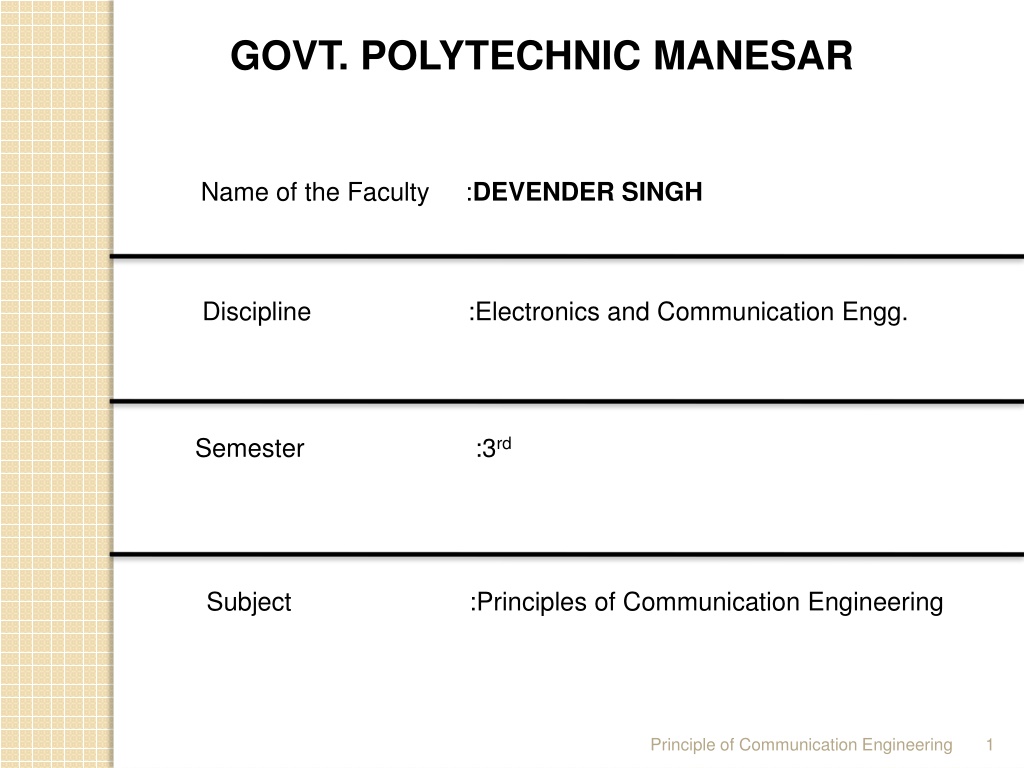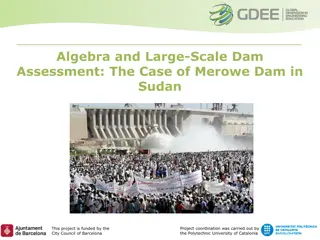GOVT. POLYTECHNIC MANESAR
Modulation, essential in communication systems, allows the transmission of multiple signals over single channels. Explore the advantages of modulation in reducing antenna size, improving reception quality, and increasing communication range.
Download Presentation

Please find below an Image/Link to download the presentation.
The content on the website is provided AS IS for your information and personal use only. It may not be sold, licensed, or shared on other websites without obtaining consent from the author.If you encounter any issues during the download, it is possible that the publisher has removed the file from their server.
You are allowed to download the files provided on this website for personal or commercial use, subject to the condition that they are used lawfully. All files are the property of their respective owners.
The content on the website is provided AS IS for your information and personal use only. It may not be sold, licensed, or shared on other websites without obtaining consent from the author.
E N D
Presentation Transcript
GOVT. POLYTECHNIC MANESAR Name of the Faculty :DEVENDER SINGH Discipline :Electronics and Communication Engg. Semester :3rd Subject :Principles of Communication Engineering Principle of Communication Engineering 1
1. INTRODUCTION Modulation is the process of varying one or more properties of a periodic waveform, called the carrier signal, with a modulating signal that typically contains information to be transmitted. Most radio systems in the 20th century used frequency modulation (FM) or amplitude modulation (AM) for radio broadcast. A modulator is a device that performs modulation. A demodulator is a device that performs demodulation, the inverse of modulation. A modem (from modulator demodulator) can perform both operations. Principle of Communication Engineering 2
Need of Modulation Modulation allows us to send a signal over a band pass frequency range. If every signal gets its own frequency range, then we can transmit multiple signals simultaneously over a single channel, all using different frequency ranges. Another reason to modulate a signal is to allow the use of a smaller antenna. The basic communication system consists of information/data transmission from one point to another like that the original/main information signal is passed through various stages and then undergoes so many changes in its orientation and features because of noise and attenuation. Principle of Communication Engineering 3
Height of Antenna Minimum antenna height= /4 = c/4f=(3* 108108)/(410103103 )=7500meters i.e. 7.5 km It is impossible to build antennae this big. Now consider a modulated signal at f= 1MHz.The minimum antenna height is given by, Minimum antenna height= /4 = c/4f=(3108108)/(410*106106 )=75 meter This length of the antenna can be built easily and this example clearly shows us how hugely the process of modulation is enabling communication systems. Principle of Communication Engineering 4
Advantages of modulation The antenna used for transmission, had to be very large, if modulation was not introduced. The range of communication gets limited as the wave cannot travel to a distance without getting distorted. Following are some of the advantages for implementing modulation in the communication systems. Antenna size gets reduced. No signal mixing occurs. Communication range increases. Multiplexing of signals occur. Adjustments in the bandwidth is allowed. Reception quality improves. Principle of Communication Engineering 5
BASIC COMMUNICATION SYSTEM Principle of Communication Engineering 6
Noise Sound is what we hear.Noise is unwanted sound. ... Sound is produced by vibrating objects and reaches the listener's ears as waves in the air or other media. When an object vibrates, it causes slight changes in air pressure. These air pressure changes travel as waves through the air and produce sound. Principle of Communication Engineering 7
External Noise External noise is defined as the type of Noise which is general externally due to communication system. External Noise are analysed qualitatively. Now, External Noise may be classified as a) Atmospheric Noise :Atmospheric Noise is also known as static noise which is the natural source of disturbance caused by lightning, discharge in thunderstorm and the natural disturbances occurring in the nature. b) Industrial Noise :Sources of Industrial noise are auto-mobiles, aircraft, ignition of electric motors and switching gear. The main cause of Industrial noise is High voltage wires. These noises is generally produced by the discharge present in the operations. c) Extraterrestrial Noise :Extraterrestrial Noise exist on the basis of their originating source. They are subdivided into i) Solar Noise ii) Cosmic Noise Principle of Communication Engineering 8
Internal Noise Internal Noise are the type of Noise which are generated internally or within the Communication System or in the receiver. They may be treated qualitatively and can also be reduced or minimized by the proper designing of the system. Internal Noises are classified as 1) Shot Noise :These Noise are generally arises in the active devices due to the random behaviour of Charge particles or carries. In case of electron tube, shot Noise is produces due to the random emission of electron form cathodes. 2) Partition Noise :When a circuit is to divide in between two or more paths then the noise generated is known as Partition noise. The reason for the generation is random fluctuation in the division. 3) Low- Frequency Noise :They are also known as FLICKER NOISE. These type of noise are generally observed at a frequency range below few kHz. Power spectral density of these noise increases with the decrease in frequency. That why the name is given Low- Frequency Noise. 4) High- Frequency Noise :These noises are also known TRANSIT- TIME Noise. They are observed in the semi-conductor devices when the transit time of a charge carrier while crossing a junction is compared with the time period of that signal. 5) Thermal Noise :Thermal Noise are random and often referred as White Noise or Johnson Noise. Thermal noise are generally observed in the resistor or the sensitive resistive components of a complex impedance due to the random and rapid movement of molecules or atoms or electrons. Principle of Communication Engineering 9
2. AMPLITUDE MODULATION Expression of Amplitude Modulated wave when the modulation is done by combining the amplitude of high frequency carrier wave with the amplitude of low frequency message wave, then it is known as amplitude modulation. carrier wave , C(t) = Ac sin ct message wave = M(t)=Am sin mt Hence the amplitude of the carrier wave is mixed with message signal. CM(t) = (Ac + Am sin mt) sin ct => CM(t) = Ac(1 + (Am/Ac) sin mt) sin ct Principle of Communication Engineering 10
Let, Am/AC = Where, = Modulation index CM(t) = Ac(1 + sin mt) sin ct => CM(t) = Ac sin ct + Ac sin mt . sin ct => CM(t) = Ac sin ct + ( Ac)/2 cos ( c - m)t - ( AC)/ 2 cos ( c + m)t which is the required expression of amplitude modulated wave. Principle of Communication Engineering 11
Carrier band components When carriers are aggregated, each carrier is referred to as a component carrier. There are two categories: Primary component carrier: This is the main carrier in any group. There will be a primary downlink carrier and an associated uplink primary component carrier. Principle of Communication Engineering 12
Waveform of AM Wave Let us assume our base or message signal to be generated as specified above. To produce an amplitude modulated wave we need to superimpose this signal with another signal of higher frequency. This signal is the Carrier Signal and differs from one carrier to another. Thus the carrier signal has a different Amplitude and Frequency as compared to the message signal. Both these signals superimpose with each other. To perform this function we use simple triode to superimpose these signals. Principle of Communication Engineering 13
Side band components The sidebands comprise all the spectral components of the modulated signal except the carrier. The signal components above the carrier frequency constitute the upper sideband (USB), and those below the carrier frequency constitute the lower sideband (LSB). All forms of modulation produce sidebands. Principle of Communication Engineering 14
Modulation index Modulation index is a measure of extent of modulation done on a carrier signal. In Amplitude modulation, it is defined as the ratio of the amplitude of modulating signal to that of the carrier signal. Principle of Communication Engineering 15
Spectrum and Bandwidth of AM Wave The spectrum of an amplitude modulated is related to the sidebands that are generated and hence to the bandwidth. 1. AM Sidebands When a carrier is modulated in any way, further signals are created either side of the steady carrier. These sidebands carry the actual modulation information. The amplitude modulation sidebands are generated above and below the main carrier. To see how this happens, take the example of a carrier on a frequency of 1 MHz which is modulated by a steady tone of 1 kHz. The process of modulating a carrier is exactly the same as mixing two signals together, and as a result both sum and difference frequencies are produced. Therefore when a tone of 1 kHz is mixed with a carrier of 1 MHz, a "sum" frequency is produced at 1 MHz + 1 kHz, and a difference frequency is produced at 1 MHz - 1 kHz, i.e. 1 kHz above and below the carrier. Principle of Communication Engineering 16
AM Bandwidth It can be seen that if the top frequency that is modulated onto the carrier is 6 kHz, then the top spectra will extend to 6 kHz above and below the signal. In other words the bandwidth occupied by the AM signal is twice the maximum frequency of the signal that is used to modulated the carrier, i.e. it is twice the bandwidth of the audio signal to be carried. t can be seen that limiting the top frequency of the modulating signal limits the overall bandwidth of the amplitude modulated signal. For audio transmissions, like broadcast transmissions, the overall bandwidth of the signal is dependent upon the highest frequencies to be transmitted. Broadcast channel spacing varies according to the band used and also the area within the world where the transmission comes from. On the Long waveband broadcast in ITU region 1 (Europe, Africa, and northern and central Asia), the channel spacing is 9 kHz, for the medium wave broadcast band the channel spacing in ITU regions 1 and 3 is 9 kHz spacing, and in ITU region 2 (Americas) it is 10kHz. To achieve these channel spacings, the audio spectrum must be limited. If no interference was to be caused to stations on adjacent channels this would severely limit the top audio frequency. On the short wave bands it would be half 5 kHz, i.e. 2.5 kHz. This would clearly not allow sufficient quality for broadcasting and therefore the bandwidth of the signals is a little higher than this and some interference is caused. Similarly on the medium and long wave bands the bandwidth of the AM signal is often higher than half the channel spacing. Interference is managed by not allowing stations in close proximity to occupy adjacent channels. Principle of Communication Engineering 17
Relative power distribution in carrier band Principle of Communication Engineering 18
DSB-SC DSB-SC is an amplitude modulated wave transmission scheme in which only sidebands are transmitted and the carrier is not transmitted as it gets suppressed. ... Thus only sidebands are transmitted that contains information. This results in saving of power used in transmission. A normal system also termed as Double Sideband Full Carrier (DSB- FC) system,transmits carrier along with the two sidebands. Hence, resulting in a considerable power loss. So, DSB-SC system is used in order to overcome the drawback of DSB-FC system. Principle of Communication Engineering 20
DSB-SC Modulation In the process of Amplitude Modulation, the modulated wave consists of the carrier wave and two sidebands. The modulated wave has the information only in the sidebands.Sideband is nothing but a band of frequencies, containing power, which are the lower and higher frequencies of the carrier frequency. Principle of Communication Engineering 21
DSB-SC Area of Application TV broadcasting Air traffic control radios key less remotes DSB-SC is a technique used in electronic communication, most commonly for transmitting information via a radio carrier wave. DSB-SC used in stereo transmission of FM radio. Two way radio communications. Principle of Communication Engineering 22
SSB-SC In radio communications,single-sideband modulation (SSB) or single-sideband suppressed-carrier modulation (SSB-SC) is a type of modulation used to transmit information, such as an audio signal, by radio waves. A refinement of amplitude modulation, it uses transmitter power and bandwidth more efficiently. Principle of Communication Engineering 23
SSB-SC Modulation Single sideband, SSB modulation is basically a derivative of amplitude modulation, AM. By removing some of the components of the ordinary AM signal it is possible to significantly improve its efficiency. It is possible to see how an AM signal can be improved by looking at the spectrum of the signal. When a steady state carrier is modulated with an audio signal, for example a tone of 1 kHz, then two smaller signals are seen at frequencies 1 kHz above and below the main carrier. Principle of Communication Engineering 24
SSB-SC Area of Application For power saving requirements and low bandwidth requirements. In land, air, and maritime mobile communications. In point-to-point communications. In radio communications. In television, telemetry, and radar communications. In military communications, such as amateur radio, etc. Principle of Communication Engineering 25
ISB In radio communications, a sideband is a band of frequencies higher than or lower than the carrier frequency, that are the result of the modulation process. The sidebands carry the information transmitted by the radio signal. Principle of Communication Engineering 26
ISB Modulation Independent sideband (ISB) is an AM single sideband mode which is used with some AM radio transmissions. Normally each sideband carries identical information, but ISB modulates two different input signals one on the upper sideband, the other on the lower sideband. Principle of Communication Engineering 27
ISB Area of Application ISB modulation is standard for the transmission of TV signals. Because the video signals require a large transmission BW using the techniques like DSB- FC otherwise DSF-SC. This is a type amplitude modulation that is mainly used for the TV broadcast worldwide. In this broadcast, it is essential to broadcast the information of video and audio concurrently. In the transmission of VSB, the higher sideband of video signal & picture carrier are broadcasted without any control. Where a vestige is a fraction of lower sideband and it is transmitted & the residual part is covered up When the usage of BW is considered, then this is the most suitable and proficient technique. Thus, this is all about ISB modulation. The most important and typical application of this modulation is for the broadcast of TV signals. Here is a question for you, what is the meaning of vestige? Principle of Communication Engineering 28
VSB Vestigial sideband (VSB) is a type of amplitude modulation (AM ) technique (sometimes called VSB-AM ) that encodes data by varying the amplitude of a single carrier frequency . Portions of one of the redundant sidebands are removed to form a vestigial sideband signal - so-called because a vestige of the sideband remains. Principle of Communication Engineering 29
VSB Modulation Vestigial Sideband Modulation or VSB Modulation is the process where a part of the signal called as vestige is modulated, along with one sideband. A VSB signal can be plotted as shown in the following figure. Along with the upper sideband, a part of the lower sideband is also being transmitted in this technique. A guard band of very small width is laid on either side of VSB in order to avoid the interferences. VSB modulation is mostly used in television transmissions. Principle of Communication Engineering 30
VSB Area of Application VSB modulation is standard for the transmission of TV signals. Because the video signals require a large transmission BW using the techniques like DSB-FC otherwise DSF-SC. This is a type amplitude modulation that is mainly used for the TV broadcast worldwide. In this broadcast, it is essential to broadcast the information of video and audio concurrently. In the transmission of VSB, the higher sideband of video signal & picture carrier are broadcasted without any control. Where a vestige is a fraction of lower sideband and it is transmitted & the residual part is covered up When the usage of BW is considered, then this is the most suitable and proficient technique. Principle of Communication Engineering 31
3. FREQUENCY MODULATION frequency modulation. A method of transmitting signals, especially in radio broadcasting, in which the value of the signal is given by the frequency of a high frequency carrier wave. Principle of Communication Engineering 33
Expression for frequency modulated wave Principle of Communication Engineering 34
Spectrum of FM Wave A spectrum represents the relative amounts of different frequency components in any signal. Its like the display on the graphic-equalizer in your stereo which has leds showing the relative amounts of bass, midrange and treble. These correspond directly to increasing frequencies (treble being the high frequency components). It is a well-know fact of mathematics, that any function (signal) can be decomposed into purely sinusoidal components (with a few pathological exceptions) . In technical terms, the sines and cosines form a complete set of functions, also known as a basis in the infinite- dimensional vector space of real-valued functions (gag reflex). Given that any signal can be thought to be made up of sinusoidal signals, the spectrum then represents the "recipe card" of how to make the signal from sinusoids. Like: 1 part of 50 Hz and 2 parts of 200 Hz. Pure sinusoids have the simplest spectrum of all, just one component: Principle of Communication Engineering 35
Modulation Index The modulation index (or modulation depth) of a modulation scheme describes by how much the modulated variable of the carrier signal varies around its un modulated level. It is defined differently in each modulation scheme. Amplitude modulation index. Frequency modulation index. Principle of Communication Engineering 36
Maximum frequency deviation The frequency deviation of a radio is of particular importance in relation to bandwidth, because less deviation means that more channels can fit into the same amount of frequency spectrum. The FM broadcasting range (87.5 108 MHz, NOTE: In some countries the 87.5 88.0 MHz part of the band is not used) uses a channel spacing of 200 kHz, with a maximum frequency deviation of 75 kHz, leaving a 50 kHz buffer above the highest and below the lowest frequency to reduce interaction with other channels. FM applications use peak deviations of 75 kHz (200 kHz spacing), 5 kHz (25 kHz spacing or 20 kHz spacing), 2.5 kHz (12.5 kHz spacing), and 2 kHz (8.33 kHz spacing, 7.5 kHz spacing, 6.25 kHz spacing or 5 kHz spacing) Principle of Communication Engineering 37
Bandwidth of FM Signal The bandwidth of an FM signal is not as straightforward to calculate as that of an AM signal. To take the example of a typical broadcast FM signal that has a deviation of 75kHz and a maximum modulation frequency of 15 kHz, the bandwidth of 98% of the power approximates to 2 (75 + 15) = 180kHz. Principle of Communication Engineering 39
Carsons Rule In telecommunication, Carson's bandwidth rule defines the approximate bandwidth requirements of communications system components for a carrier signal that is frequency modulated by a continuous or broad spectrum of frequencies rather than a single frequency. Carson's rule does not apply well when the modulating signal contains discontinuities, such as a square wave. Carson's rule originates from John Renshaw Carson's 1922 paper. Carson's bandwidth rule is expressed by the relation: where is the bandwidth requirement is the peak frequency deviation;is the highest frequency in the modulating signal. Principle of Communication Engineering 40
Effect of noise on FM carrier FM systems are far better at rejecting noise than AM systems.Noise generally is spread uniformly across the spectrum (the so-called white noise, meaning wide spectrum). The amplitude of the noise varies randomly at these frequencies. Principle of Communication Engineering 41
Noise triangle It is seen that noise in AM and PM remains constant for entire audio range because the modulation index due to signal are independent on modulating frequency but in FM the effect of noise will be increased with the increase in modulating frequency. Principle of Communication Engineering 42
Role of limiter Limiter circuit is used in FM receiver to remove the noise present in the peaks of the received signal and to remove any amplitude variation in the received signal; the output of the limiter has constant amplitude. Principle of Communication Engineering 43
Pre-emphasis In high speed digital transmission,pre-emphasis is used to improve signal quality at the output of a data transmission. In transmitting signals at high data rates, the transmission medium may introduce distortions, so pre-emphasis is used to distort the transmitted signal to correct for this distortion. Principle of Communication Engineering 44
De-emphasis De-emphasis means attenuating those frequencies by the amount by which they are boosted. However pre-emphasis is done at the transmitter and the de-emphasis is done in the receiver. The purpose is to improve the signal-to-noise ratio for FM reception. Principle of Communication Engineering 45
Capture effect In a radio receiver, the capture effect, or FM capture effect, is a phenomenon associated with FM reception in which only the stronger of two signals at, or near, the same frequency or channel will be demodulated. Principle of Communication Engineering 46
Narrow Band FM Narrow band FM, NBFM, is used for signals where the deviation is small enough that the terms in the Bessel function is small and the main sidebands are those appearing at modulation frequency. The sidebands further out are negligible. For NBFM, the FM modulation index must be less than 0.5, although a figure of 0.2 is often used. For NBFM the audio or data bandwidth is small, but this is acceptable for this type of communication. Principle of Communication Engineering 47
Wide Band FM When spectrum efficiency is important, Narrowband FM (NBFM) is used but when better signal quality is required,Wideband FM (WBFM) is used at the expense of greater spectrum usage. The term WBFM is used in applications where the modulation index is equal to or larger than 1. Principle of Communication Engineering 48
4. Principles of AM Modulators If an input signal's height varies with the loudness of a user's voice and then adds this to the carrier, then the carrier's amplitude will change corresponding to the input signal that's been fed into it. This is called amplitude modulation or AM.Frequency of an input signal can also be changed. Principle of Communication Engineering 49
AM Transmitter In AM, the voltage or power level of the information signal changes the amplitude of the carrier in proportion With no modulation, the AM carrier is transmitted by itself. So are CB radios, aircraft radios, and the video modulation of a TV broadcast transmitter. ... Principle of Communication Engineering 50




















